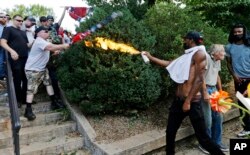The deadly white nationalist demonstration in Virginia has brought new attention to an anti-fascist movement whose black-clad, bandana-wearing members have been a regular presence at protests around the country in the last year.
Members of the “antifa” movement were among those protesting the Charlottesville rally last weekend. During a combative news conference Tuesday, President Donald Trump did not mention antifa by name but said there was blame “on both sides” for the violence. He said the counter-demonstrators charged at white nationalists with clubs and suggested they also had a hand in escalating the violence.
“You had a group on one side that was bad, and you had a group on the other side that was also very violent, and nobody wants to say that, but I'll say it right now,” Trump said.
Here are some facts about the antifa movement and those who protested the rally:
What is "antifa?"
“Antifa” is short for anti-fascists and emulates historic anti-fascist actors in Europe.
It's an umbrella term covering different groups that organize largely on the internet, said Mark Smith, political science professor at the University of Washington. According to websites and Facebook posts, people who affiliate with the term take a militant approach against fascism and white nationalism that doesn't necessarily shy away from violence.
A website that appears to have been created by a group of anti-fascists in Sacramento, California, says anti-fascism opposes the power structures of white supremacy, patriarchy and capitalism and strives to dismantle all systems that promote prejudice and oppression.
The site also says they have no leaders, official members or spokespeople.
In April, pro-Trump demonstrators at a planned Ann Coulter talk in Berkeley called for antifa to be declared a terrorist organization. Others disagree with that assessment.
“There's extremist ideology and then there's extremist tactics,” said Oren Segal, the director of Anti-Defamation League's Center on Extremism. His organization does not directly track antifa groups but says they come up in their work because of their opposition to the hate groups they do track, he said.
The ADL opposes antifa's use of violence in part because “it helps the white supremacist narrative of victimization become a more effective talking point,” he said.
Smith rejects the claim that both sides are equal, saying the movements of neo-Nazis and white nationalists are at least in part what's driving the antifa movement.
What did antifa do in Charlottesville?
Both sides did engage in violence Saturday. For nearly an hour, fights broke out among a crowd of hundreds of people who gathered in the street before the rally was set to start.
Antifa members were among those protesting the white nationalists, along with Black Lives Matter protesters, clergy members and others. In the mass of hundreds of people, it was not always possible to see who was instigating the fights.
In a combative news conference at Trump Tower, the president acknowledged that there were “some very bad people” among those who gathered to protest Saturday. But he added, “You also had people that were very fine people, on both sides.”
He also said he had “no doubt” that blame laid with both groups.
The comments drew a swift rebuke from political leaders of both parties.
Charlottesville Mayor Mike Signer said Wednesday that he did not think it was fair for the president to equate the actions of those protesting racism and fascism to the white nationalists.
“The spark for that whole event was Nazis and KKK members choosing to launch a public event with the intent of inciting mayhem. I place the blame for the entire event at their feet,” he said.
What about the so-called “alt-left?”
In recent weeks, conservatives have described violent protesters who have been clashing with conservatives at political rallies as the “alt-left” or “alternative left.” Trump used the newly coined term several times Tuesday.
The “alt-left” seems to encompass far-left-leaning militant groups that disrupt or resist what they see as fascist activity, countering neo-Nazis and white supremacists at demonstrations and other events.
The “alt-right” movement has been described as a mix of racism, white nationalism, populism and anti-Semitism. It emphasizes preserving and protecting the white race in the United States.
Where else has antifa protested?
In the hundreds of protests against Trump since his election, there have been rare, scattered incidents of violence. Those episodes usually involve select anarchists or members of the anti-fascist movement that see violence as a way to fight the state and protect the vulnerable.
Yong Jung-Cho of the activist group All of Us said in June that only “a real small percentage of people” on the left engage in violence.
“This is the challenge of large social movements - there's a lot of people in them.”
A group identified as anti-fascists demonstrated in Portland, Oregon, in June - many wearing masks and black clothing - during a larger rally with other counter-protesters that was organized by a pro-Trump conservative group. Police used flash-bang grenades and pepper spray to disperse the anti-fascist crowd. They said protesters hurled bricks and other objects at officers.
A prominent San Francisco Bay Area anti-fascist leader, Yvonne C. Felarca, was recently arrested on charges stemming from a state Capitol brawl last year between white nationalist groups and counter-protesters.
Felarca has been prominent at several clashes in Berkeley involving the Occupy movement and more recently between supporters and opponents of Trump and conservative leaders.
The first time Smith heard the word antifa, he said, was in connection with the January shooting by a purported Trump supporter of a man protesting an appearance by right-wing speaker Milo Yiannopoulos at the University of Washington.
That protest involved people wearing black clothing and bandanas and carrying signs that said “Make Fascists Afraid Again,” among other slogans. The look and actions were not new to the Pacific Northwest, a region that Seattle Police Department spokesman Sean Whitcomb said has always had a strong anarchist presence.
“The two groups are not dissimilar,” he said.









